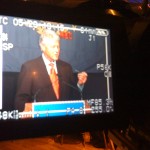10 tips for video recording presentations

President Bill Clinton in New Hampshire
10 tips for video recording presentations
We wanted to share some tips for recording people. No doubt everyone has seen dark, blurry, shaky camera shots of CEOs giving important speeches. This is often the result of someone saying “It’s just a presentation, we don’t need anything fancy.” If it’s important enough to have it recorded, then it’s just as important to do it correctly. Below are some suggestions for recording people when there’s no time to hire a crew.
1. Get GREAT audio
People can tolerate bad video but they cannot put up with bad audio. Built-in camera microphones should only be used as an extreme back up. The best thing to do is get a wired sound feed from the sound mixer. If that’s not possible, putting a mic near a PA speaker and away from crowd chatter also works.
2. Camera placement
Plan where you’re going to put your camera as early as possible. If there’s a video projection screen being used, be sure the screen isn’t behind the presenter in your shot. Presenters often look toward their slides, and having them turn toward your camera will always look better than seeing the back of their head. If you’re in an old building, floors tend to move and creak as people walk by you. Look for a solid spot to drop your tripod (yes, ALWAYS use a tripod).
3. Lighting
Light is the third leg of the stool when it comes to getting great recording results. You can have the best camera and the best microphones, but without decent light, you have nothing. Many hotels have track lighting in ballrooms and sometimes it’s a simple nudge with a long pole to get the light pointed at the podium. If all the lights in the room are on one switch and the lights go off for the slides, you’ll quickly lose your person in the dark abyss. We can’t stress enough how important a basic lighting setup is.
4. Power
Try setting up near a power outlet. You’ll have less cable to run and less chance of someone accidentally kicking the plug out of the wall. Always bring batteries as a backup, and bring enough to last the length of the presentation.
5. Height
Set your camera high enough so people’s heads aren’t in the way. This often means a camera height of at least 6 ½ feet. At that height, it can be difficult to see the viewfinder or simply operate the camera controls. The good news is most hotels will set up a stage riser for you. Ask for a bar stool too, which will make shooting the event that much easier
6. Zoom range
This really goes under camera placement. Make sure your camera can zoom in far enough to frame a decent shot of the person. If you’re all the way zoomed in, remember any motion will be amplified on screen. Having a great tripod will help this situation.
7. Recording duration
If it’s important to capture uninterrupted content, be sure your recording device can go long enough without needing a noisy tape change or media card replaced.
8. PowerPoint slides
Many people have PowerPoint slides integrated with their presentation. Decide in advance the importance of capturing the actual slides. Moving a camera back and forth between the presenter and the bright projection screen can be extremely distracting to the viewer. Our advice is to stick with the person and add in the slides after the event.
9. Backup
So you’ve done all of the above, and all of a sudden your camera stops working. Today’s tiny Flip-type cameras can save the day, and even some Smartphones will do the trick. Just remember, it’s almost always about the audio.
10. Permission
Never take for granted that you’ll be allowed to videotape an event. Always ask the organizers and presenter if it’s OK to record them and state what you intend to do with the footage. Ninety percent of the time, they’ll just want a copy of the footage.
We hope the above tips will help you the next time you have to videotape something. Of course, we always remind clients that we do travel and have many years of experience doing exactly what most people don’t like doing.



